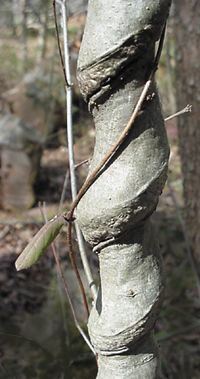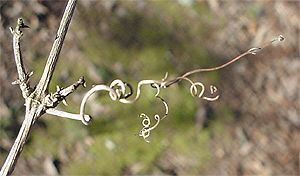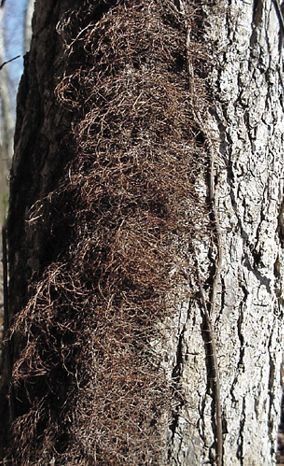"GETTING HIGH" WITH SUCKERS,
TENDRILS, AND ADVENTITIOUS ROOTS
By definition, a vine is a "weak-stemmed plant that derives its support from climbing, twining, or creeping along a surface." In contrast, shrubs and trees are nicely adapted for standing out in a crowd, their woody stems allowing them to rise above surrounding vegetation, get closer to sunlight, and even shade out the competition. But pity the poor vine that lies prostrate on the ground--unless, of course, it's able to grow skyward by leaning on all those big, strong trees and shrubs around it.
 All photos & text © Hilton Pond Center
All photos & text © Hilton Pond Center
Here at Hilton Pond Center, vines demonstrate more than one way to "get high." Herbaceous ones such as Maypops (Passiflora incarnata) and Indian Strawberries (Duchesnea indica) don't live long enough to climb very far,  but several of our woodier vines are perennials that snake up tree trunks all the way to the canopy. Japanese Honeysuckle (Lonicera japonica), a semi-woody import from Asia that has fragrant blossoms but a murderous disposition, demonstrates the easiest way to climb: grow skyward by just winding around the trunk of a tree or shrub. Unfortunately for its support network, honeysuckle twines so tightly that when the tree trunk grows and expands, the vine constricts flow of water and food and often chokes the life out of its host (right). If the tree dies and eventually falls, the killer honeysuckle also crashes back to earth--but not before it has produced jillions of shiny blue-black berries that are carried off by birds to make jillions more honeysuckle vines. We suspect that in Asia there are enough honeysuckle predators to keep this plant in check, but such is not the case in North America, and our woodlands suffer for it. but several of our woodier vines are perennials that snake up tree trunks all the way to the canopy. Japanese Honeysuckle (Lonicera japonica), a semi-woody import from Asia that has fragrant blossoms but a murderous disposition, demonstrates the easiest way to climb: grow skyward by just winding around the trunk of a tree or shrub. Unfortunately for its support network, honeysuckle twines so tightly that when the tree trunk grows and expands, the vine constricts flow of water and food and often chokes the life out of its host (right). If the tree dies and eventually falls, the killer honeysuckle also crashes back to earth--but not before it has produced jillions of shiny blue-black berries that are carried off by birds to make jillions more honeysuckle vines. We suspect that in Asia there are enough honeysuckle predators to keep this plant in check, but such is not the case in North America, and our woodlands suffer for it.
Native Piedmont vines are a bit more genteel in how they use trees and shrubs to scale the heights.  Greenbrier (Smilax spp., top photo), identifiable by its sharp, straight thorns and thin, green stems, produces tendrils that wind around tree twigs and other projections, holding the vine in place. Tendrils live a relatively short time before withering and losing their grip, but by then the Greenbrier is already higher in the tree and growing new tendrils. Similar structures are used by wild grapes such as Muscadines (Vitis rotundifolia), and by Cross Vine (Anisostichus capreolata, above left). Interestingly, Greenbrier tendrils are modified leaves, while in grapes they are modified stems. Greenbrier (Smilax spp., top photo), identifiable by its sharp, straight thorns and thin, green stems, produces tendrils that wind around tree twigs and other projections, holding the vine in place. Tendrils live a relatively short time before withering and losing their grip, but by then the Greenbrier is already higher in the tree and growing new tendrils. Similar structures are used by wild grapes such as Muscadines (Vitis rotundifolia), and by Cross Vine (Anisostichus capreolata, above left). Interestingly, Greenbrier tendrils are modified leaves, while in grapes they are modified stems.
Orange-flowered Trumpet Creeper (Campsis radicans)--known at Hilton Pond Center as the "amazing hummingbird magnet vine"-- is in the same family (Bignoniaceae) as Cross Vine, but it doesn't grow thin, looping tendrils. Instead it sends out short, finger-like adventitious roots that dig into dead bark on a host tree and hold tightly while the vine grows. These aerial roots (right) apparently absorb no water or nutrients and do no damage to the host. is in the same family (Bignoniaceae) as Cross Vine, but it doesn't grow thin, looping tendrils. Instead it sends out short, finger-like adventitious roots that dig into dead bark on a host tree and hold tightly while the vine grows. These aerial roots (right) apparently absorb no water or nutrients and do no damage to the host.
Another native vine, Poison Ivy (Rhus radicans), sometimes grows along the ground or as a low shrub, but when crawling up a vertical support it produces adventitious roots to the extreme. An old Poison Ivy vine is usually covered by so many hair-like aerial roots that the vine looks downright furry (below left). As in Trumpet Creeper, these holdfasts are non-damaging to the host tree, but they do contain urushiol, the toxic oil that causes dermatitis in many people. (HINT: Don't stroke the inviting fur of a Poison Ivy vine.)
 Perhaps our favorite viny tree-climbing is done by Virginia Creeper, which also happens to bear one of our favorite scientific names: Parthenocissus quinquefolia. This woody native plant produces thin, flexible vines that can grow along virtually any vertical surface. Like the wild grapes to which it is related, Virginia Creeper produces stem tendrils, but their branched tips form into flat disks that produce a sticky substance. Once the mucilage dries and anchors the disk, the tendril coils or contracts and pulls the vine closer to its support (below right). This grasping mechanism is so powerful that Virginia Creeper can adhere to tree trunks, cliff faces, brick chimneys, and even plate glass windows. It's no wonder that Virginia Creeper often grows just as tall as the tree that supports it, and that it thrives in hardwood forests where trees are allowed to mature. Perhaps our favorite viny tree-climbing is done by Virginia Creeper, which also happens to bear one of our favorite scientific names: Parthenocissus quinquefolia. This woody native plant produces thin, flexible vines that can grow along virtually any vertical surface. Like the wild grapes to which it is related, Virginia Creeper produces stem tendrils, but their branched tips form into flat disks that produce a sticky substance. Once the mucilage dries and anchors the disk, the tendril coils or contracts and pulls the vine closer to its support (below right). This grasping mechanism is so powerful that Virginia Creeper can adhere to tree trunks, cliff faces, brick chimneys, and even plate glass windows. It's no wonder that Virginia Creeper often grows just as tall as the tree that supports it, and that it thrives in hardwood forests where trees are allowed to mature.
 In the tropics, vine species are far more numerous than in the temperate Carolina Piedmont, and tropical vines likely have diverse means of dragging themselves up from the shady forest floor. Nonetheless, the various mechanisms described above are easily observed almost anywhere in the U.S. and southern Canada and illustrate quite nicely that, at Hilton Pond Center and beyond, vines indeed have found more than one way to "get high." In the tropics, vine species are far more numerous than in the temperate Carolina Piedmont, and tropical vines likely have diverse means of dragging themselves up from the shady forest floor. Nonetheless, the various mechanisms described above are easily observed almost anywhere in the U.S. and southern Canada and illustrate quite nicely that, at Hilton Pond Center and beyond, vines indeed have found more than one way to "get high."
All photos & text © Hilton Pond Center
If you enjoy "This Week at Hilton Pond," please help Support
Hilton Pond Center for Piedmont Natural History.
It's painless, and YOU can make a difference!
You may wish to consult our Index of all nature topics covered since February 2000.
For a free, non-fattening, on-line subscription to "This Week at Hilton Pond," just send an e-mail with "Subscribe" in the subject line to THIS WEEK
|


 but several of our woodier vines are perennials that snake up tree trunks all the way to the canopy. Japanese Honeysuckle (Lonicera japonica), a semi-woody import from Asia that has fragrant blossoms but a murderous disposition, demonstrates the easiest way to climb: grow skyward by just winding around the trunk of a tree or shrub. Unfortunately for its support network, honeysuckle twines so tightly that when the tree trunk grows and expands, the vine constricts flow of water and food and often chokes the life out of its host (right). If the tree dies and eventually falls, the killer honeysuckle also crashes back to earth--but not before it has produced jillions of shiny blue-black berries that are carried off by birds to make jillions more honeysuckle vines. We suspect that in Asia there are enough honeysuckle predators to keep this plant in check, but such is not the case in North America, and our woodlands suffer for it.
but several of our woodier vines are perennials that snake up tree trunks all the way to the canopy. Japanese Honeysuckle (Lonicera japonica), a semi-woody import from Asia that has fragrant blossoms but a murderous disposition, demonstrates the easiest way to climb: grow skyward by just winding around the trunk of a tree or shrub. Unfortunately for its support network, honeysuckle twines so tightly that when the tree trunk grows and expands, the vine constricts flow of water and food and often chokes the life out of its host (right). If the tree dies and eventually falls, the killer honeysuckle also crashes back to earth--but not before it has produced jillions of shiny blue-black berries that are carried off by birds to make jillions more honeysuckle vines. We suspect that in Asia there are enough honeysuckle predators to keep this plant in check, but such is not the case in North America, and our woodlands suffer for it. Greenbrier (Smilax spp., top photo), identifiable by its sharp, straight thorns and thin, green stems, produces tendrils that wind around tree twigs and other projections, holding the vine in place. Tendrils live a relatively short time before withering and losing their grip, but by then the Greenbrier is already higher in the tree and growing new tendrils. Similar structures are used by wild grapes such as Muscadines (Vitis rotundifolia), and by Cross Vine (Anisostichus capreolata, above left). Interestingly, Greenbrier tendrils are modified leaves, while in grapes they are modified stems.
Greenbrier (Smilax spp., top photo), identifiable by its sharp, straight thorns and thin, green stems, produces tendrils that wind around tree twigs and other projections, holding the vine in place. Tendrils live a relatively short time before withering and losing their grip, but by then the Greenbrier is already higher in the tree and growing new tendrils. Similar structures are used by wild grapes such as Muscadines (Vitis rotundifolia), and by Cross Vine (Anisostichus capreolata, above left). Interestingly, Greenbrier tendrils are modified leaves, while in grapes they are modified stems. is in the same family (Bignoniaceae) as Cross Vine, but it doesn't grow thin, looping tendrils. Instead it sends out short, finger-like adventitious roots that dig into dead bark on a host tree and hold tightly while the vine grows. These aerial roots (right) apparently absorb no water or nutrients and do no damage to the host.
is in the same family (Bignoniaceae) as Cross Vine, but it doesn't grow thin, looping tendrils. Instead it sends out short, finger-like adventitious roots that dig into dead bark on a host tree and hold tightly while the vine grows. These aerial roots (right) apparently absorb no water or nutrients and do no damage to the host. Perhaps our favorite viny tree-climbing is done by Virginia Creeper, which also happens to bear one of our favorite scientific names: Parthenocissus quinquefolia. This woody native plant produces thin, flexible vines that can grow along virtually any vertical surface. Like the wild grapes to which it is related, Virginia Creeper produces stem tendrils, but their branched tips form into flat disks that produce a sticky substance. Once the mucilage dries and anchors the disk, the tendril coils or contracts and pulls the vine closer to its support (below right). This grasping mechanism is so powerful that Virginia Creeper can adhere to tree trunks, cliff faces, brick chimneys, and even plate glass windows. It's no wonder that Virginia Creeper often grows just as tall as the tree that supports it, and that it thrives in hardwood forests where trees are allowed to mature.
Perhaps our favorite viny tree-climbing is done by Virginia Creeper, which also happens to bear one of our favorite scientific names: Parthenocissus quinquefolia. This woody native plant produces thin, flexible vines that can grow along virtually any vertical surface. Like the wild grapes to which it is related, Virginia Creeper produces stem tendrils, but their branched tips form into flat disks that produce a sticky substance. Once the mucilage dries and anchors the disk, the tendril coils or contracts and pulls the vine closer to its support (below right). This grasping mechanism is so powerful that Virginia Creeper can adhere to tree trunks, cliff faces, brick chimneys, and even plate glass windows. It's no wonder that Virginia Creeper often grows just as tall as the tree that supports it, and that it thrives in hardwood forests where trees are allowed to mature. In the tropics, vine species are far more numerous than in the temperate Carolina Piedmont, and tropical vines likely have diverse means of dragging themselves up from the shady forest floor. Nonetheless, the various mechanisms described above are easily observed almost anywhere in the U.S. and southern Canada and illustrate quite nicely that, at Hilton Pond Center and beyond, vines indeed have found more than one way to "get high."
In the tropics, vine species are far more numerous than in the temperate Carolina Piedmont, and tropical vines likely have diverse means of dragging themselves up from the shady forest floor. Nonetheless, the various mechanisms described above are easily observed almost anywhere in the U.S. and southern Canada and illustrate quite nicely that, at Hilton Pond Center and beyond, vines indeed have found more than one way to "get high."


